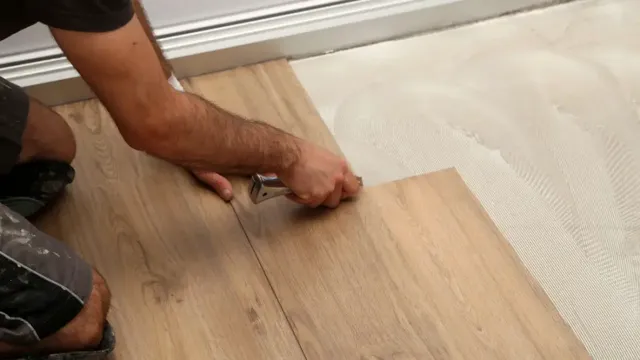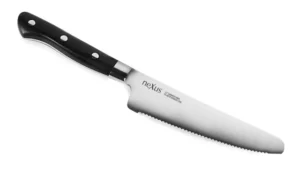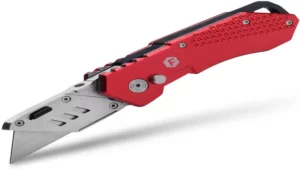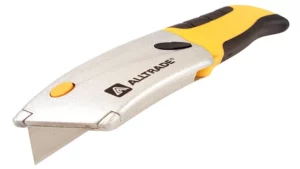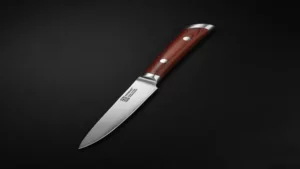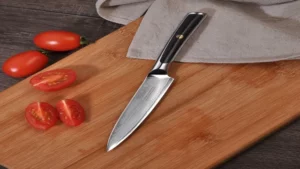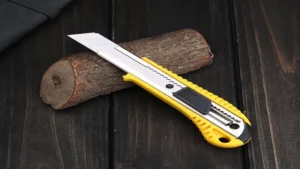When it comes to cutting vinyl flooring, there are plenty of tools at your disposal. From a saw to a straight edge, the options can be overwhelming. But what about a trusty utility knife? Believe it or not, this simple tool can be a game-changer when cutting vinyl flooring.
Not only is it easy to use, but it can also be more precise than other tools on the market. One of the benefits of using a utility knife is that it allows you to make small cuts with ease. This is especially useful if you’re working with a tricky corner or a tight space.
The blade is sharp enough to slice through the vinyl with minimal effort, and the compact size makes it easy to maneuver. Plus, since the blade is retractable, you can adjust the length based on your needs. Another advantage of using a utility knife for vinyl flooring is that it’s affordable.
While some saws can be pricey, a high-quality utility knife won’t break the bank. This is great news if you’re on a budget or just starting out with DIY projects. Plus, since the blade can be replaced as needed, you don’t have to worry about constantly buying new tools.
Of course, there are some downsides to using a utility knife for vinyl flooring. For one thing, it can take longer than other tools to make cuts. Additionally, you’ll need a steady hand to keep the blade on track and avoid mistakes.
But if you’re willing to put in the extra effort, a utility knife can be a fantastic choice for cutting vinyl flooring.
Introduction
Are you wondering if you can cut vinyl flooring with a utility knife? The answer is a resounding yes! In fact, using a utility knife is one of the most common methods for cutting vinyl flooring. Not only is it a quick and simple solution, but it’s also affordable since you likely already have a utility knife in your toolbox. When cutting vinyl flooring with a utility knife, it’s important to use a straight edge or ruler as a guide to ensure your cuts are clean and precise.
Additionally, be sure to use a sharp blade and change it out frequently to avoid jagged edges or tears in the material. With a steady hand and proper technique, you’ll be able to cut your vinyl flooring with ease using a trusty utility knife.
Overview of Vinyl Flooring
Vinyl flooring is a popular and cost-effective option for anyone looking to spruce up their home or business. It is made of several layers of materials, including polyvinyl chloride (PVC), which gives it its durability and resistance to water and stains. Vinyl flooring comes in a range of colors, styles, and patterns, making it a versatile option for any interior design.
With its easy installation process, vinyl flooring is a great choice for do-it-yourselfers or those working on a budget. Plus, it requires minimal maintenance and is easy to clean. Vinyl flooring is a go-to option for areas of high traffic, such as kitchens, bathrooms, and hallways, where its durability comes in handy.
Overall, vinyl flooring is a practical, beautiful, and affordable option for anyone looking to revamp their floors.

Tools Required: Utility Knife and Straight Edge
Utility Knife and Straight Edge are two of the most basic tools required in any DIY project or repair work. These handy tools can save you a lot of time and effort and make the job much easier to do. A utility knife is a versatile tool known for its sharp blade that can cut through materials such as cardboard, leather, and plastic.
On the other hand, a straight edge is a long, narrow tool with a flat edge that can be used to measure and make straight cuts. Together, they form a powerful duo that can handle a range of tasks such as trimming wallpaper, cutting foam insulation board, or trimming carpets. They are essential tools for any DIY enthusiast or home repair person, and everyone should have them in their toolbox.
So, whether you are planning a DIY project or just need to make some simple cuts, a utility knife and straight edge are the perfect tools for the job.
Methodology
If you’re looking for a quick, easy way to cut vinyl flooring, using a utility knife might be an option. However, it’s important to keep in mind that there are various factors to consider before you start cutting. Firstly, make sure you have a sharp blade, as a dull one can cause damage to the vinyl and make cutting more difficult.
Secondly, ensure that the vinyl is completely flat and secured to the floor before you begin. This will help to prevent any buckling or warping while cutting. When cutting, use a ruler or straight edge to guide your knife and make clean, precise cuts.
It’s also a good idea to make multiple passes over the vinyl to avoid tearing or uneven edges. Overall, cutting vinyl flooring with a utility knife can be a great DIY option, but make sure to take your time and follow these tips for best results.
Preparation of the Work Area
Preparation of the work area is an essential step in any job. Without proper preparation, there will be a higher risk of injury, accidents, and poor quality of work. To begin with, every worker should be equipped with the necessary Personal Protective Equipment (PPE), depending on the nature of the job.
This includes goggles, gloves, hard hats, and steel-toed boots. The work area should be clean and free from debris, tools properly organized, and power sources disconnected before commencing any work. For instance, if the job involves drilling through a wall, ensure that there are no pipes or electrical connections behind the wall.
Remember to use cautionary tape and warning signs to caution passers-by. Lastly, work from the top and proceed downwards, this ensures that the worker does not come into contact with any spillages, debris, or hazardous chemicals accidentally. In summary, adequate preparation makes all the difference.
Marking the Cut Lengths with a Pencil
When it comes to cutting material for a project, marking your cut lengths beforehand can save you time and headaches in the long run. One simple and effective method is to use a pencil to mark the lengths on the material itself. Begin by measuring and marking your desired length with a pencil at one end of the material.
Then, use a straight edge or ruler to draw a straight line from the mark to the opposite end, ensuring it is parallel to the edge. Repeat this process for each length you need to cut. This method will allow you to easily follow your marked lines when cutting, resulting in accurate and precise cuts every time.
Plus, since the marks are made with a pencil, they can easily be erased or corrected if needed. By taking the time to mark your cut lengths in advance, you’ll be helping to ensure the success of your project.
Cutting the Vinyl Flooring using a Utility Knife
Cutting vinyl flooring can feel daunting, but with the right tools and techniques, it can be done with ease. One of the best ways to cut vinyl flooring is by using a utility knife. To start, measure the space where you need to fit the flooring and mark it using a straight edge or chalk line.
Once marked, place the flooring on a flat surface like a work table or cutting board. Using a sharp, new blade in your utility knife, make a shallow cut along the marked line. Be sure to apply firm pressure, but not too much as to avoid causing any damage to the flooring.
Once the initial pass is made, repeat the process a few times until the flooring is cut all the way through. Don’t forget to wear safety gloves and eyewear while cutting to avoid injury. With these simple steps, you can easily cut vinyl flooring to fit your space perfectly.
Tips for a Straight Cut
When it comes to achieving a straight cut, the methodology you choose can make all the difference. First and foremost, it’s important to have the right tools on hand. A sharp blade and a straight edge or ruler are essential.
Once you have your materials, make sure your workspace is clean and clutter-free. Next, take your time and be patient. Rushing through a cut can lead to mistakes that are difficult to fix.
Use slow and deliberate movements as you guide the blade along the edge, making sure to maintain a consistent amount of pressure. Remember, practice makes perfect. With time and experience, you’ll become more confident in your ability to achieve a straight cut every time.
Maintenance of Utility Knife
Can you cut vinyl flooring with a utility knife? The answer is yes, you certainly can! However, it’s important to ensure that your utility knife is well-maintained and sharp. This can be done by regularly sharpening the blade and making sure it’s free of rust or debris. It’s also important to use the appropriate blade for the job – for cutting vinyl flooring, a sharp, pointed blade with a serrated edge is best.
Keeping your utility knife in good condition will not only make it more effective for cutting vinyl flooring, but will also ensure that it lasts for a long time. With a well-maintained utility knife, you’ll be able to tackle any DIY project with ease!
Changing the Blade
Utility knife maintenance is essential to ensure that it operates effectively and safely. One of the most critical aspects of this maintenance is changing the blade regularly. Not only can a dull blade reduce productivity and accuracy, but it can also be dangerous to use.
The process of changing the blade on a utility knife will vary depending on the specific knife model. However, it generally involves loosening the blade locking mechanism and removing the old blade carefully. Once the old blade is removed, users can replace it with a new one and secure it back in place.
It is also vital to clean the knife regularly, ensuring there is no debris buildup that could compromise the blade’s effectiveness. Remember to dispose of old blades safely, as they can be sharp and hazardous. By regularly implementing these simple maintenance practices, one can ensure that their utility knife is always in top working order, safe, and efficient.
Storing the Utility Knife Properly
Properly maintaining your utility knife is crucial to ensure its longevity and optimal performance. One important aspect of maintenance is storing the knife properly when not in use. Leaving it unprotected can lead to damage, dullness, and even injury.
To avoid these issues, it’s best to store the knife in a designated holder or sheath, away from other tools or sharp objects. This not only protects the blade but also keeps it easy to find when needed. Additionally, it’s important to clean and dry the knife before storing it to prevent corrosion and rust.
A well-maintained utility knife not only lasts longer, but also provides a safer and more effective cutting experience. Remember, taking some simple steps to properly store and maintain your utility knife can go a long way in enhancing its performance and safety.
Safety Precautions to Follow
Yes, you can cut vinyl flooring with a utility knife, but it’s important to take safety precautions. Make sure you have a sharp blade to prevent the knife from bouncing around or snagging the material. It’s also crucial to wear eye protection and gloves to avoid injury.
In addition, it’s recommended to use a straightedge or ruler to make precise cuts and to avoid accidentally cutting yourself. Remember to keep your work area clean and free of debris. Using a utility knife can be a handy way to cut vinyl flooring, but make sure you take the necessary steps to protect yourself and ensure a quality finished product.
Protective equipment
Protective equipment When it comes to keeping yourself safe while on the job, protective equipment is a crucial aspect to consider. Whether you’re working in construction, manufacturing, or any other industry, safety should always come first. Wearing proper protective gear can significantly reduce the risk of injury or harm, allowing you to perform your job with confidence.
Some essential equipment to consider includes hard hats, safety glasses, steel-toed boots, gloves, and earplugs. It’s also important to ensure that your gear is properly fitted and regularly inspected for wear and tear. By taking these simple precautions, you can protect yourself from accidents and ensure a safer workplace for everyone.
Don’t skimp on safety – invest in quality protective equipment to keep yourself protected at all times.
Avoiding Contact with Obstacles
When maneuvering through obstacles, it’s important to prioritize safety and take the necessary precautions to avoid collisions. Firstly, always wear appropriate safety gear, including a helmet and protective clothing, to minimize the risk of injury. Additionally, take the time to familiarize yourself with the terrain and map out your path before setting off.
This will help you identify potential hazards and plan ahead to avoid them. It’s also important to maintain a safe speed based on your level of experience and the conditions of the terrain. Remember, slow and steady wins the race! Lastly, don’t be afraid to dismount and walk your bike through particularly tricky sections.
It’s better to take your time and ensure your safety than risk a dangerous accident. By following these safety precautions, you can confidently navigate through obstacles and enjoy a safe and exhilarating ride.
Conclusion
In conclusion, while it may be possible to cut vinyl flooring with a utility knife, it’s not necessarily the best tool for the job. Like using a butter knife to cut steak, you may end up with a less than ideal result. Instead, consider investing in a proper flooring cutter or blade to ensure a clean and precise cut.
Your floors (and fingers) will thank you in the long run!”
Safety First
When it comes to staying safe, there are several precautions that you should follow. First and foremost, always wear appropriate safety gear, such as helmets or gloves, when engaging in activities that could lead to injury. It’s also important to stay aware of your surroundings and pay attention to warning signs or barriers.
Additionally, make sure that any equipment or tools you are using are working properly and are used in the correct way. Finally, if you are feeling unwell or fatigued, take a break and rest. Remember, safety should always come first, no matter what activity you are engaging in.
By following these simple precautions, you can help prevent injuries and ensure that you stay safe.
Conclusion: Cutting Vinyl Flooring with a Utility Knife
When it comes to cutting vinyl flooring with a utility knife, it’s essential to follow some safety precautions to avoid any accidents or injuries. Firstly, always wear gloves to protect your hands from potential cuts or scrapes. Secondly, make sure the flooring is secure and stable before starting the cutting process to prevent any mishaps.
It’s also vital to keep the cutting area clear of any clutter or obstacles that may cause you to trip or stumble. Additionally, ensure that the blade of your utility knife is sharp and in good condition to prevent slipping and minimize the amount of effort required to cut through the vinyl. Remember that cutting vinyl is not difficult, but it does require precision and accuracy, so take your time, be patient, and focus on your task.
FAQs
What is vinyl flooring made of and can it be cut with a utility knife?
Vinyl flooring is typically made of PVC and other additives. It can be easily cut with a utility knife or a sharp box cutter.
Is it safe to cut vinyl flooring with a utility knife?
Yes, it is safe to cut vinyl flooring with a utility knife as long as you follow proper safety measures and use a sharp blade.
What type of utility knife blade should I use to cut vinyl flooring?
A sharp, heavy-duty utility knife blade with a serrated edge is recommended for cutting vinyl flooring.
Can a regular pair of scissors be used to cut vinyl flooring?
While a pair of scissors could be used to cut vinyl flooring, it is not recommended as it may cause the vinyl to tear or fray.
Do I need any special equipment to cut vinyl flooring?
Aside from a utility knife, a straight edge or ruler, and a cutting mat or scrap piece of wood to protect the surface, no special equipment is needed to cut vinyl flooring.
Can vinyl flooring be cut without creating dust or debris?
Cutting vinyl flooring with a utility knife may create some dust or debris, but it can be minimized by making sure the blade is sharp and using a vacuum or broom to clean up afterward.
Is it necessary to use a specific cutting technique when cutting vinyl flooring with a utility knife?
While there is no specific cutting technique required, it is important to take your time and make slow, steady cuts to ensure a precise and clean cut.
